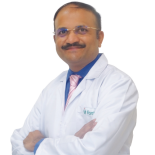Fortis Institute of Robotic Surgery - BG Road, Bengaluru
About Fortis Hospital BG Road Bangalore
Fortis Hospital on Bannerghatta Road in Bengaluru is a well-equipped medical facility with 284 beds and top-notch infrastructure. It is staffed by highly skilled doctors, paramedical, and support personnel, focusing on evidence-based practices for quality care. The hospital specializes in super-specialty tertiary care across 40 medical fields, including Cardiac Sciences, Neurology, Oncology, and Robotic Surgery. With over 150 doctors and 800 para-medical staff, it offers services like Emergency Care, Organ Transplants, and Preventive Care. Fortis Hospital has earned accreditation from NABH four times and JCI five times. It is recognized as one of the top five global destinations for medical tourism by MTQUA, making it a standout in the healthcare industry.
Fortis Hospital, Bannerghatta Road, excels in Robotic Surgery, achieving significant progress in visualization, precision, control, and dexterity, transforming the surgical experience for patients. Robotic assistance offers benefits like faster recovery, reduced scarring, minimized blood loss, and decreased post-operative discomfort, enabling quicker return to daily activities and shorter hospital stays. With an advanced robotic system, the hospital performs intricate procedures with unmatched accuracy, especially in challenging areas like the highly vascular pelvic region and neck. Leveraging extensive expertise, the hospital conducts successful minimally invasive surgeries using robotic technology for optimal patient outcomes
Specialities
Our Team of Experts
 Dr. Mohan KeshavamurthySENIOR DIRECTOR UROLOGY
Dr. Mohan KeshavamurthySENIOR DIRECTOR UROLOGY Dr. Sandeep NaikSENIOR DIRECTOR SURGICAL ONCOLOGY
Dr. Sandeep NaikSENIOR DIRECTOR SURGICAL ONCOLOGY Dr. Sudarshan G TSENIOR CONSULTANT CARDIO THORACIC VASCULAR SURGERY
Dr. Sudarshan G TSENIOR CONSULTANT CARDIO THORACIC VASCULAR SURGERY Dr. Rubina Shanawaz ZCONSULTANT OBSTETRICS & GYNAECOLOGY
Dr. Rubina Shanawaz ZCONSULTANT OBSTETRICS & GYNAECOLOGY Dr. Bharath GCONSULTANT SURGICAL ONCOLOGY
Dr. Bharath GCONSULTANT SURGICAL ONCOLOGY Dr. Karibasavaraja NeelagarADDITIONAL DIRECTOR UROLOGY
Dr. Karibasavaraja NeelagarADDITIONAL DIRECTOR UROLOGY Dr. Manish Joshi & Team
Dr. Manish Joshi & Team Dr. Gayathri Dinesh KamathADDITIONAL DIRECTOR OBSTETRICS & GYNAECOLOGY
Dr. Gayathri Dinesh KamathADDITIONAL DIRECTOR OBSTETRICS & GYNAECOLOGY Dr. B Karthik RaoADDITIONAL DIRECTOR UROLOGY
Dr. B Karthik RaoADDITIONAL DIRECTOR UROLOGY Dr. Usha B RCONSULTANT OBSTETRICS & GYNAECOLOGY
Dr. Usha B RCONSULTANT OBSTETRICS & GYNAECOLOGY
FAQs
What is the Robotic Surgical System?
It is a system consisting of three parts:
Surgeon Console is the control centre where your surgeon sits to perform the operation.
Patient Cart holds the camera and surgical instruments your surge on controls from the console.
Vision Cart manages the communication between all the system components and provides a screen for the care team to view the operation.Why is your surgeon suggesting Robotic Assisted Surgery? What are the benefits?
Surgical Robotic Systems have been widely adopted by surgeons and benefited millions of patients. More than 8.0 million robotic-assisted procedures have taken place worldwide, roughly, every 26 seconds, a patient somewhere in the world gets operated through Robotic Assisted Surgeries.
Just as technology, such as MRI and CT scanners enhance clinicians’ skills beyond what the human body allows, RAS system extends the capabilities of a surgeon’s eyes and hands. With RAS your surgeon:
• Stays with you in the operating room and uses his or her hands to control a camera and surgical instruments to perform the procedure.
• Views the entire operation in 3-dimensional high definition (3DHD), giving your surgeon a crystal- clear view of the surgical area that is magnified 10 times to what the human eye sees.
• Uses tiny instruments that move like a human hand but with an even greater range of motion. The system’s built-in tremor-filtration technology helps your surgeon to move each instrument with smooth precision.
By providing surgeons with superior visualisation, enhanced dexterity, greater precision and ergonomic comfort, Robotic surgical systems make it possible for skilled surgeons to perform minimally invasive procedures involving complex dissection or reconstruction.Which type of robot is used for robotic surgery?
Fortis Hospitals boasts of highly advanced, latest 4th generation robotic surgery system - the DaVinci Robotic platform.
How surgeons determine the eligibility of a patient for robotic surgery?
In most cases, surgeons check whether the patient’s case is feasible enough for robotic surgery. If yes, this surgery is recommended with complete details about the procedure, benefits, effects, costs and time. Most patients follow their surgeons’ advice in regard to surgical procedure.
Why Robotic Surgery?
1. Smaller incisions and less scarring
2. Precision in surgery
3. Fewer complications
4. Less postoperative pain and Less need for pain medication
5. Reduced hospital stay and faster healing
6. Quicker return to normal activity


